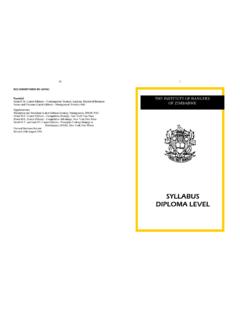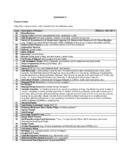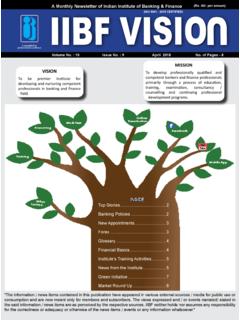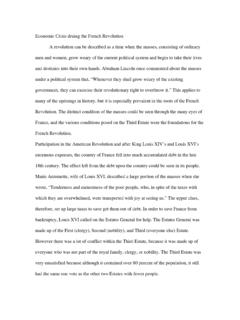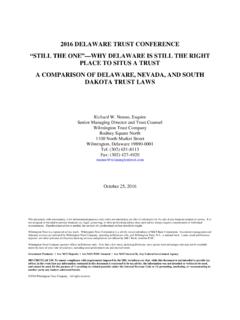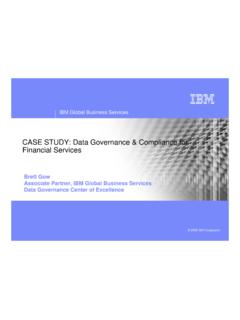Transcription of THE INSTITUTE OF BANKERS OF ZIMBABWE - …
1 24 SYLLABUS INTERMEDIATE LEVEL THE INSTITUTE OF BANKERS OF ZIMBABWE 2 INSTITUTE OF BANKERS OF ZIMBABWE FINANCIAL ACCOUNTING 11- REVISEDSYLLABUS IMPLEMENTATION DATE: The Nature of the Subject This syllabus has been designed to provide candidates with an understanding of principles and procedures related to company accounting. The syllabus also intends to develop in candidates the ability to focus on the needs of users when preparing financial statements. Aims and Objectives At the end of the course, candidates should be able to explain the theoretical framework of accounting in relation to the structure and contents of company financial statements prepare a full set of general purpose financial statements for financial institutions and corporate entities in other sectors analyse and interpret various aspects of the performance of financial institutions and other corporate entities identify and explain the information needs of financial institutions in relation to the operations of their clients account for the operations of small and medium-sized enterprises The Examination The Examination will be of three hours duration, plus ten minutes reading time during which period candidates may write on the Question Paper but not in their Answer Book.
2 Syllabus Candidates should note that it is not the intention to examine subject areas shown below individually. Rather, answers will provide the opportunity for candidates to demonstrate their knowledge and abilities over the whole of the syllabus, or at least those areas that are appropriate to the question. The examination will cover the following areas: 23 4. Determination of Banker/Customer Relationship action to be taken on the death, mental disorder or insolvency of customers, or upon receipt of garnishee, injunction, sequestration or other legal process. 5. Security (a) Suitability of (b) as security for all types (first or subsequent) charge (b) Appropriate methods of valuation and forms of charge. Steps to perfect the security and to enable release or repayment or otherwise or realisation on default: - Quoted and unquoted stocks and shares - Life Policy - Land and Building, domestic and industrial - Notarial and Covering Bonds - Book Debts - Cession of Contracts - Produce and goods - Agricultural charges - Guarantees and letters of comfort (c) Common problems encountered when taking security and upon the enforcement of securities, including competing interests.
3 RECOMMENDED TEXTS The Banker and the Law - A Fourie A practical approach to securities in ZIMBABWE SRG Monckton FIBZ: PG Dip BA; IOBZ Law Relating to Financial Services (3rd Edition), Graham Roberts, CIB Publishing 1998 22 Candidates should note that one of the Questions may be multiple-choice, in which case such Question will be compulsory. Calculators may not be used in this examination. Syllabus Candidates should note that it is not the intention to examine subject areas shown below individually. Rather, answers will provide the opportunity for candidates to demonstrate their knowledge and abilities over the whole of the syllabus or at least those areas that are appropriate to the question, The examination will cover the following areas, 1. Banker Customer Relationships (a) The general and special relationships between banker and customer; their respective rights and duties and the resultant practice involved in all features of banking transactions and banking business.
4 All aspects of issues relating to Safe Custody services are included in this context (b) The special relationships arising out of mandates and powers of attorney, appropriation of payments, set-off, lien, confidentiality, status Opinions and indemnities given by or to the banker. 2. Banking Transactions (a) Payment and collection of cheques and other Instruments. The respec-tive rights and duties of drawee, drawer and the banker, including statutory and other protections. (b) Debit and credit clearing systems. The collection of cheques and other instruments. Standing orders and direct debits. (c) Electronic payment systems plastic payment cards and the mandatory functions of a banker; 3. Types of Account Holder Banking practice in opening and conducting accounts, whether in credit or debit, for all types of customers: - Personal customers including minors - joint accounts customers - executors, administrators and trustees - solicitors, estate agents and insurance brokers - unincorporated clubs and societies - partnerships - limited companies 3 The theoretical framework of accounting (a) The accounting provisions of the Companies Act (Chapter 24:03) and Statutory Instruments 62 of 1996 (b) The accounting provisions of the Private Business Corpo-rations Act (Chapter 24.)
5 11) Bills of exchange and promissory notes Partnerships Revaluation of assets Admission to, retirement from and dissolution of partnerships Buying a business as a going concern, including pre-incorporation profits Conversion of a partnership into a company Corporate Accounting Formation of companies and issue of shares and debentures Redemption of shares and debentures including a company s purchase of its own shares Taxation in company financial statements Preparation of company financial statements in compliance with statements and guidelines on generally accepted accounting practice, including the following selected international ac-counting standards (IASs) and international financial reporting standards. IAS 1 Presentation of financial statements IAS 7 Cash flow statements IAS 8 Accounting policies, changes in accounting esti-mates and errors IAS 10 Events after the balance sheet date IAS 12 Income taxes IAS 17 Leases 4 IAS 21 The effects of changes in foreign exchange rates IAS 23 Borrowing costs IAS 28 Investments in associates IAS 29 Financial reporting in hyperinflationary economies IAS 31 Interests in joint ventures IAS 32 Financial instruments: presentation IAS 36 Impairment of assets IAS 37 Provisions, contingent liabilities and contingent Assets IAS 39 Financial instruments.
6 Recognition and Measurement IFRS 1 First-time adoption of international financial reporting standardsIFRS 3 Business combinations IFRS 5 Non-current assets held for sale and discontinued operations IFRS 7 Financial instruments: disclosures Analysis and interpretation of financial statements with respect to profitability, liquidity, gearing and investment ratios Consolidated and group accounts at an elementary level Candidates will be expected to make the main consolidation adjustments under the acquisition method for distributable profits, minority interests and goodwill. These adjustments relate to consolidated income statements balance sheets and cash flow statements. How ever the following topics are specifically excluded: Complex groups, piecemeal acquisition and disposal of subsidiaries. Transactions of a special nature: investments, underwriting, royalties, consignments, hire purchase transactions and accounting for branches.
7 21 Recommended Texts Marketing of Financial Services - Mclver and Naylor - CIB Principles of Marketing - Kator, Armstrong Prentice Hall Marketing of Financial Services - A Meidan Financial Services Marketing - A Reader by A Meidan. B Lewis and L Moutinho Marketing of Financial Services - C Ennew INSTITUTE OF BANKERS OF ZIMBABWE EXAMINATION SYLLABUS DIPLOMA LEVEL PRACTICE OF BANKING 1 The Nature of the Subject This syllabus has been devised to enable candidates to show that they have a good understanding of the legal context and practical implications of day to day banking operations, as they would be likely to occur in the daily routines of a bank branch. It covers most types of banking operations and situations that will be encountered in such a situation, involving all types of customers, Considerable emphasis is placed upon the differing types of customer and, where they differ, the rules and practice relating to each.
8 Other areas tested include different banking transactions and the regulations which govern them, the banker customer relationship and its determination as well as security, as regards its suitability and how to charge it to the best advantage. Candidates will be required to demonstrate their comprehension of the situations presented and their implications for both, bank and customer, as well as identifying and commenting upon resultant situations arising from the scenarios that ale presented. Aims and Objectives of the Examination To enable the candidates to demonstrate their understanding of banking operations, banker/customer relationships, the conduct of different types of accounts and all aspects of the taking and release of securities for advances. Candidates should ensure that they are familiar with the legal aspects pertaining to this examination before attempting this subject. The Examination The examination will last for three hours, plus fifteen minutes reading time during which period candidates may write on the Question Paper but not in their Answer Book, 20 4.
9 Direct Marketing (a) The nature of direct marketing (b) The use of direct marketing (c) The importance of a marketing database (d) The advantages and disadvantages of direct marketing to existing and potential customers and to the organisation (e) Measuring the success of direct marketing. 5. Advertising and Public Relations (a) The nature of advertising (b) Why companies advertise (c) The use of advertising (d) The role of advertising (e) The nature and role of public relations (f) Developing an advertising plan (g) Control of advertising (h) Financial services advertising regulations 6. Communication with customers (a) The importance of the customer (b) Communicating with existing and new customers (c) Communicating the message (d) The need to get the message across (e) Enhancing direct contact with customers (f) Professional connections: developing and maintaining (g) Information technology as a communication tool.
10 7. Service and customer Care (a) Product knowledge and service (b) Interpersonal skills and service (c) Customer expectations (d) Customer types (e) Customer safety and security (f) Commission and interest: understanding and explaining to customers (g) The cost of poor service and customer care. 8. The Selling Process (a) The role of sales targets (b) Anticipating customer needs (c) Generating leads (d) Identifying the customer's needs (e) Satisfying the need - solving the problem (f) Benefit statements (g) Closing the sale (h) Follow-up 5 Recommended Texts Business Accounting2 by F. Wood & A. Sangster 9th edition-Pearson Education Ltd. Accounting for ZIMBABWE Vol. 2 by Paradza 2nd Edition Modern Business Publications Inc Financial Accounting 2 Denmark Training Services (Pvt) Ltd. Recommended Reading for Financial Account-ing II Title Introduction to IFRS Publishers Lexis Nexis Authors Q Vorster; C Koornhof; J Oberholster; Z Kop-peschaar; S Coetzee and other Title Group Statements: Volume 1 Publishers Lexis Nexis Authors C S Binnekade and Z R Koppeschaar Title Descriptive Accounting IFRS Focus Publishers Lexis Nexis Authors Q Vorster; C Koornhof; J Oberholster; Z Kop-peschaar; S Coetzee and other FOR BOTH FIN ACC I AND II FRANK WOOD ACCOUNTING I - IFRS EDI-TION FRANK WOOD ACCOUNTING II - IFRS EDI-TION OLDER EDITIONS OUT OF DATE 6 INSTITUTE OF BANKERS OF ZIMBABWE EXAMINATION SYLLABUS INTERMEDIATE LEVEL FINANCE OF INTERNATIONAL TRADE I The Nature of the Subject The syllabus had been designed to enable candidates to indicate their familiarity with some of the financial aspects of International Trade.
